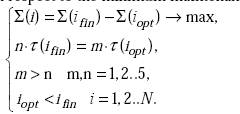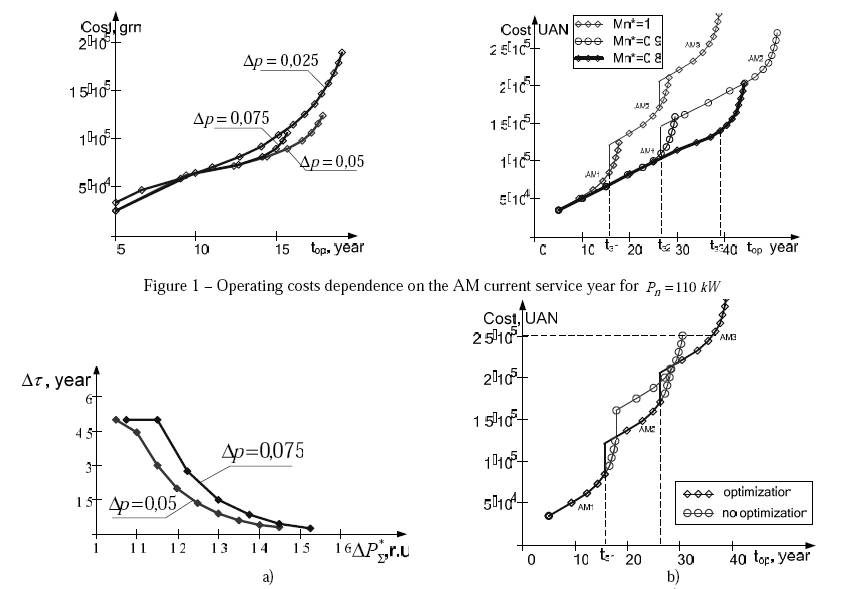Introduction.
Improving the production process at industrial enterprises requires science-based approach to its planning, cost analysis of new technology and economic incentives for its implementation. In addition to the wellknown solutions and methods of the operation modes analysis there are a number of issues that should be studied. These issues include: the evaluation of the electrical machines energy efficiency, methods of the technical inspection and repair planning, methods and tools for diagnosis and prediction of the defects in equipment. Mentioned methods can be considered as means of providing the following tasks:
- improving the production reliability due to timely repair and replacement of the asynchronous motors;
- reducing the maintenance costs for unscheduled repairs of the electrical machines, production downtime and motor’s consumption of the excess power.
Objectives.
Development of an algorithm for the determination of the optimal asynchronous motor replacement with respect to the minimum maintenance cost criterion, where the increasing of the total motor loss after each repair is also taken into account.
Materials and findings.
The statistics proves that the park of the electromechanical equipment of Ukrainian enterprises mainly consists of machines have been operating for many years and repaired many times. According to the industry experience and studies, the characteristics of such machines are much different as compared with new equipment. This difference is conditioned by the change of the construction materials characteristics and above all – electrical steel characteristics during operation, preparation for repair and repair. This process is accompanied by induction decrease, that results in steel saturation and increase in the magnetization current becoming non-sinusoidal.
The experimental studies show that after 3-5 overhauls the core losses in the induction motor are increased from 5% to 20% after every next repair.
It is obvious that the losses increase leads to the overheating of the stator and rotor windings, that results in much faster deterioration of the winding isolation as compared with the rated losses, therefore – the motor life is reduced and the number of repairs is increased. The company suffers from growing expenses caused by motor lifetime decreasing as compared with the rated, turnaround time reducing, cost increasing of next repairs (the cost of repair of the general industrial asynchronous motor is from 30% to 60% of the new equipment cost), production downtime, power consumption costs increasing.
Benefits of the algorithm for the determination of the optimal replacement time of the asynchronous motor can be calculated as a sum of following items:
- cost cutting due to electric power consumption reducing when the old motor is timely replaced with the new one;
- cost cutting due to reducing the number of repairs per a prescribed period;
- cost cutting due to the determination of the accurate motor lifetime and timely preventive repairs;
- cost cutting due to reducing the downtime related to the overhauls.
The algorithm development requires following assumptions:
- determination of the electric machine lifetime is based on the well-known “eight degrees’ rule
- temperature of the windings insulation varies in proportion to the motor heating loss;
- AM operating cost is calculated for continuous running mode;
- operating cost is calculated by average daily electricity prices;
- the first AM overhaul occurs after 5 years of the operation;
- motor operation stops when the turnaround time is decreased to 2,5 months.
The algorithm for determination of the AM optimal replacement time has been developed on the basis of AM energy losses.
The first block of the algorithm – is a block of all input parameters: the rated motor’s parameters, the cost of one kilowatt of the consumed power, the motor price, the repair cost, the working days per year, the number of working shifts, working shift hours, ratio of losses increasing after each repair.
Turnaround time is calculated with the equation:

The main criteria for calculation of the AM current service year are: the first AM overhaul occurs after 5 years of the operation; motor operation stops when the turnaround time is equal to 3 months

The AM operating cost after i-th repair consists of: the motor price, number of repairs, repair cost and consumed electric energy cost taking into account the motor total loss increasing after each repair:

The last block of the algorithm – is a decision-making block about optimal replacement period of the asynchronous motor, the number of motors per cycle, the cost of operation and economic benefits. This procedure is performed by constant comparison of the operation cost of given n and recommended m number of motors. Thus, we determine the optimal replacement time of the motor with respect to the minimum maintenance cost criterion:

The calculations have been made as follows. First, the motor lifetime has been calculated with the class of the windings isolation. Then, the optimal replacement time of the motor has been calculated with given algorithm, where the increasing of the motor total loss after each repair and reducing turnaround time are also taken into account. The calculations have been carried out for such cases:

Given curves clearly show that AM economic efficiency falls abruptly after several overhauls. Figure 1-a) demonstrates the increasing of the motor total losses due to overhauls frequency increasing, that results in a sharp increase of operating costs at instant of time. Thus, the figure 2-b) illustrates that fixed operating costs can guarantee AM lifetime increasing almost by 10 years under the condition of timely replacement. It should be noted that the forms of constructed curves are uniform for motors with different capacities. That's why the algorithm can be used for various AM types.

Figure 2 – AM turnaround time dependence on the relative total losses - a); motor lifetime calculated with the algorithm (optimization) and with rated parameters (no optimization) – b)
Conclusions.
The suggested technique allows determining the optimal replacement time of the asynchronous motor with respect to the minimum maintenance cost criterion. Its application will reduce the expenses of industrial enterprises related to the operation of electromechanical equipment with deteriorated energy characteristics. This algorithm allows making a decision about motor replacing on the basis of its actual technical condition, without history of its operation. Improving the reliability of the algorithm results is possible due to using it in combination with the method of AM losses calculation based on instantaneous stator currents and voltages.
Economic benefits of the algorithm is greatly increased in a large fleet of electric motors of different capacities at the industry.
The algorithm accuracy is possible to be increased due to application of the reliable methods for losses determination in various units of AM, as well as extension of the range of electromechanical equipment operation modes that can be taken into account in the algorithm.